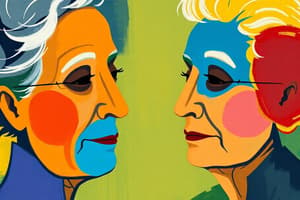Podcast
Questions and Answers
How do social support systems differ for older Black Americans compared to other ethnic groups, and what are the implications for their care?
How do social support systems differ for older Black Americans compared to other ethnic groups, and what are the implications for their care?
Older Black Americans are less likely to seek help outside of family members, relying on social security as their main source of retirement income. This may result in a lack of access to healthcare and other resources, exacerbating existing health disparities.
What are the barriers to healthcare access experienced by older Hispanic Americans, and how do these barriers impact their health outcomes?
What are the barriers to healthcare access experienced by older Hispanic Americans, and how do these barriers impact their health outcomes?
Older Hispanic Americans face inadequate healthcare, high illiteracy rates, and low occupational rates, which contribute to a high percentage of the community living below the poverty line. This can lead to poor health outcomes, including higher rates of chronic diseases.
How do cultural norms and values impact the aging experiences of older Asian Americans, and what are the implications for their care?
How do cultural norms and values impact the aging experiences of older Asian Americans, and what are the implications for their care?
In Asian American culture, the oldest son is traditionally expected to care for elderly parents, but this trend has been declining since 2000. This shift may result in a lack of support for older adults, and impact their care outcomes.
What are the similarities and differences in the aging experiences of older Black, Hispanic, and Asian Americans, and how do these differences impact their care outcomes?
What are the similarities and differences in the aging experiences of older Black, Hispanic, and Asian Americans, and how do these differences impact their care outcomes?
How do socioeconomic factors, such as poverty and inadequate healthcare, impact the aging experiences of older adults from different ethnic groups?
How do socioeconomic factors, such as poverty and inadequate healthcare, impact the aging experiences of older adults from different ethnic groups?
What theory of aging best describes the retired teacher who continues to teach at the prison, and how does their experience support this theory?
What theory of aging best describes the retired teacher who continues to teach at the prison, and how does their experience support this theory?
How do community activities like square dancing and pickle ball at the renovated mall in Bentonville, AR promote positive views on aging among older adults?
How do community activities like square dancing and pickle ball at the renovated mall in Bentonville, AR promote positive views on aging among older adults?
How might Harminder Kaur's work as a registered nurse in a skilled nursing facility (SNF) be influenced by the Modernization Theory of aging?
How might Harminder Kaur's work as a registered nurse in a skilled nursing facility (SNF) be influenced by the Modernization Theory of aging?
What role do socioeconomic factors play in shaping the aging experiences of older adults, and how might this impact Harminder Kaur's approach to care?
What role do socioeconomic factors play in shaping the aging experiences of older adults, and how might this impact Harminder Kaur's approach to care?
How might the diversity of the elderly population in Harminder Kaur's care impact her approach to promoting cultural competence in care?
How might the diversity of the elderly population in Harminder Kaur's care impact her approach to promoting cultural competence in care?
What is the primary goal of the 'Explain' phase in the perception of the client's situation, and how does it relate to the caregiver's point of view?
What is the primary goal of the 'Explain' phase in the perception of the client's situation, and how does it relate to the caregiver's point of view?
How do ethnic groups perceive aging, and what is the significance of this perception in care?
How do ethnic groups perceive aging, and what is the significance of this perception in care?
What are the characteristics of the current generation of elderly, and how does this diversity impact care?
What are the characteristics of the current generation of elderly, and how does this diversity impact care?
How does the socioeconomic status of older adults impact their aging experience, and what are the implications for care?
How does the socioeconomic status of older adults impact their aging experience, and what are the implications for care?
What is the significance of the video 'Cultural Diversity in Aging' in understanding the experiences of older adults, and how can it inform care?
What is the significance of the video 'Cultural Diversity in Aging' in understanding the experiences of older adults, and how can it inform care?
What are the primary challenges faced by elderly Native Americans, and how do they impact their health and well-being?
What are the primary challenges faced by elderly Native Americans, and how do they impact their health and well-being?
What percentage of the aging population is projected to be comprised of African Americans, Hispanics, and Whites by 2050?
What percentage of the aging population is projected to be comprised of African Americans, Hispanics, and Whites by 2050?
What was the significance of the Tuskegee Airman experiment, and what can healthcare professionals learn from it?
What was the significance of the Tuskegee Airman experiment, and what can healthcare professionals learn from it?
Why is it essential for healthcare professionals to consider cultural and linguistic factors when caring for older adults?
Why is it essential for healthcare professionals to consider cultural and linguistic factors when caring for older adults?
How do socioeconomic factors impact aging experiences across different ethnic groups, and what are the implications for healthcare?
How do socioeconomic factors impact aging experiences across different ethnic groups, and what are the implications for healthcare?
What is the primary mechanism by which free radicals contribute to biological aging, and how can they be generated in the cell?
What is the primary mechanism by which free radicals contribute to biological aging, and how can they be generated in the cell?
How does inflamm-aging lead to accelerated biological aging, and what are the potential consequences for older adults?
How does inflamm-aging lead to accelerated biological aging, and what are the potential consequences for older adults?
What is the role of mitochondrial dysfunction in aging, and how does it contribute to the development of age-related diseases such as Alzheimer's?
What is the role of mitochondrial dysfunction in aging, and how does it contribute to the development of age-related diseases such as Alzheimer's?
How does the role theory of aging influence an individual's sense of purpose and identity in older adulthood, and what are the implications for healthcare providers?
How does the role theory of aging influence an individual's sense of purpose and identity in older adulthood, and what are the implications for healthcare providers?
What are the potential implications of health disparities in older adults for healthcare providers, and how can cultural competence be used to address these disparities?
What are the potential implications of health disparities in older adults for healthcare providers, and how can cultural competence be used to address these disparities?
What is the significance of self-reflection in the context of Gerotranscendence Theory, and how can healthcare professionals incorporate this concept into their care approach for older adults?
What is the significance of self-reflection in the context of Gerotranscendence Theory, and how can healthcare professionals incorporate this concept into their care approach for older adults?
How does the concept of continuity in the Continuity Theory relate to the provision of person-centered care for older adults, and what are the implications for healthcare outcomes?
How does the concept of continuity in the Continuity Theory relate to the provision of person-centered care for older adults, and what are the implications for healthcare outcomes?
What role do cultural beliefs and values play in shaping the aging experiences of older adults from diverse ethnic backgrounds, and how can healthcare professionals ensure culturally competent care?
What role do cultural beliefs and values play in shaping the aging experiences of older adults from diverse ethnic backgrounds, and how can healthcare professionals ensure culturally competent care?
How does the Social Exchange Theory relate to the concept of control and autonomy in older adults, and what are the implications for healthcare policies and practices?
How does the Social Exchange Theory relate to the concept of control and autonomy in older adults, and what are the implications for healthcare policies and practices?
What are the potential consequences of disengagement, as described in the Disengagement Theory, for older adults' social relationships and overall well-being, and how can healthcare professionals mitigate these effects?
What are the potential consequences of disengagement, as described in the Disengagement Theory, for older adults' social relationships and overall well-being, and how can healthcare professionals mitigate these effects?
What is the underlying concern of the families of the residents regarding the nurses speaking Hindi in front of the patients?
What is the underlying concern of the families of the residents regarding the nurses speaking Hindi in front of the patients?
What is the term for the process by which individuals from one culture adapt to another?
What is the term for the process by which individuals from one culture adapt to another?
Which obstacle to cross-cultural caring is exemplified by the belief that 'all old people are forgetful'?
Which obstacle to cross-cultural caring is exemplified by the belief that 'all old people are forgetful'?
What is the expectation of nurses in terms of providing care that challenges ethnocentrism and negative stereotyping?
What is the expectation of nurses in terms of providing care that challenges ethnocentrism and negative stereotyping?
What behavior demonstrates cultural proficiency in nursing?
What behavior demonstrates cultural proficiency in nursing?
What is a significant challenge to providing culturally competent care in healthcare settings with diverse elderly populations?
What is a significant challenge to providing culturally competent care in healthcare settings with diverse elderly populations?
What is the importance of understanding the diversity of the elderly population in healthcare settings?
What is the importance of understanding the diversity of the elderly population in healthcare settings?
How do socioeconomic factors impact the aging experiences of older adults from different ethnic groups?
How do socioeconomic factors impact the aging experiences of older adults from different ethnic groups?
What is the significance of cultural norms and values in the aging experiences of older adults from different ethnic groups?
What is the significance of cultural norms and values in the aging experiences of older adults from different ethnic groups?
What is the ultimate goal of promoting cultural competence in care for older adults from diverse ethnic groups?
What is the ultimate goal of promoting cultural competence in care for older adults from diverse ethnic groups?
Flashcards are hidden until you start studying




